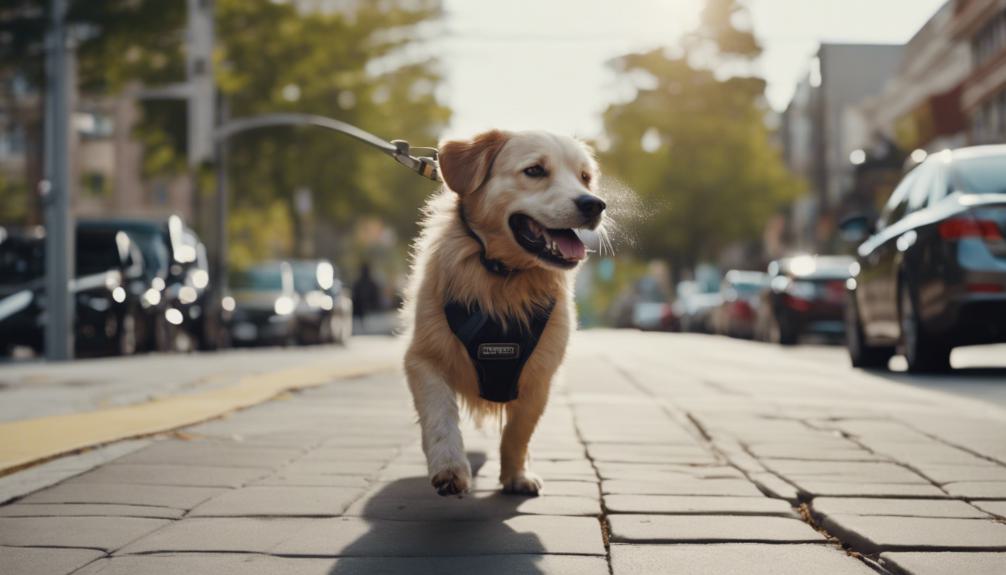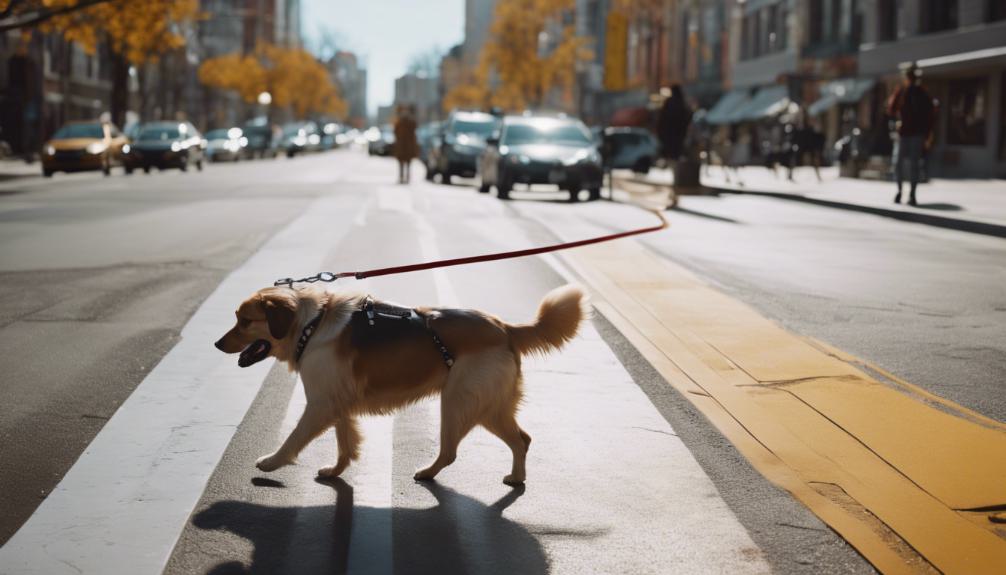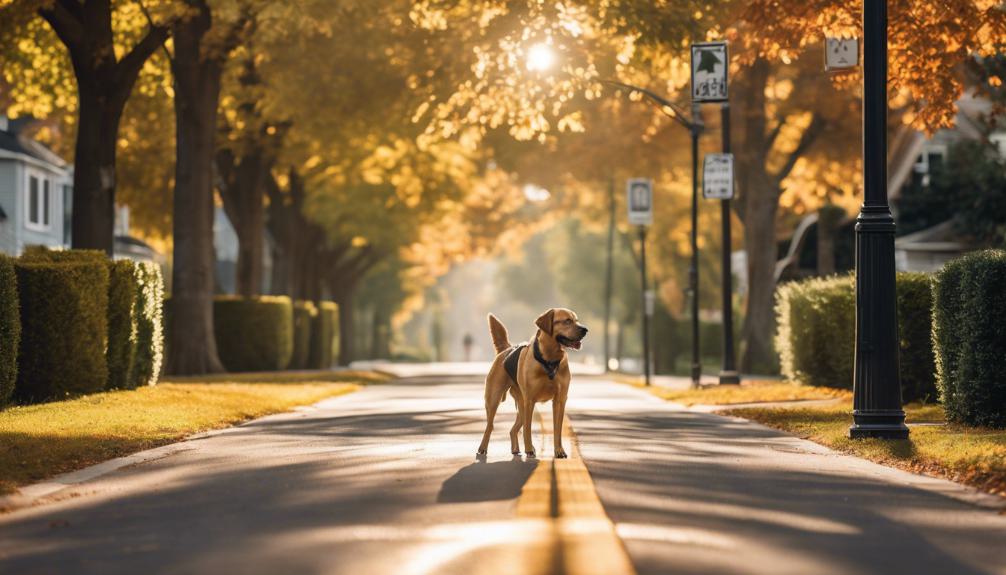How to Train a Dog Road Sense? Safe Road Tips for Dogs
To train your dog’s road sense, establish safe zones for training within your property. Use positive reinforcement like treats and praise to teach them where to be and reinforce good behavior. Teach traffic awareness and leash discipline gradually by exposing them to street environments. Monitor progress, adjust techniques, and tailor training to their needs. Consistency and patience are key in reinforcing road safety behaviors and building obedience. Following these steps will guarantee your dog’s safety and responsible pedestrian behavior. Further tips await to enhance your furry friend’s road sense.
Establishing Safe Zones for Training
To establish a secure training environment, create safe zones within your property where positive reinforcement can help your dog learn to respect boundaries. Training your dog in these enclosed areas not only guarantees their safety but also aids in teaching them road sense. By utilizing these designated safe zones, you can effectively teach your dog to understand where they should be and where they shouldn’t venture.
This controlled environment allows for focused learning on respecting boundaries and staying within safe parameters. With consistent training and positive reinforcement in these areas, your dog can develop the necessary road sense to navigate potentially hazardous situations with caution and awareness. Remember, creating these safe zones is the first step in safeguarding your dog’s safety and well-being while also promoting good road etiquette.
Using Positive Reinforcement Techniques
When training your dog for road safety, rewarding good behavior is key.
Consistency in your training approach helps reinforce positive habits.
Rewarding Good Behavior
Reward good behavior in dogs near roads by using positive reinforcement techniques like treats, praise, or toys to encourage safe habits.
During a training session, utilize these rewards to reinforce road safety and positive behavior. By associating obeying commands with positive outcomes, dogs learn to follow instructions near roads.
Positive reinforcement, such as treats and praise, helps teach essential road sense behaviors like sitting and waiting before crossing. Dogs thrive on positive experiences, making treats and toys important tools for teaching road safety effectively.
Consistent positive reinforcement not only aids in road safety training but also strengthens the bond between you and your dog, improving communication and rapport during training sessions.
Consistency in Training
For effective road safety training, maintaining consistency in using positive reinforcement techniques is crucial to instilling reliable behavior in dogs. Consistent training helps dogs understand what’s expected of them on the road and reinforces positive behaviors.
To achieve this, dog owners should:
- Establish a routine for training sessions to reinforce road safety principles regularly.
- Use treats or verbal praise consistently to reward good behavior during training.
- Practice road safety skills in various environments to guarantee dogs generalize their knowledge.
- Stay patient and persistent, as building road sense in dogs takes time and repetition.
Teaching Traffic Awareness and Leash Discipline

To enhance your dog’s safety around traffic, it is crucial to instill a strong sense of traffic awareness and leash discipline during training. Teaching your dog to stop and wait before crossing roads and maintaining leash discipline can prevent unexpected accidents. Positive reinforcement plays an essential role in reinforcing good behavior near traffic. Consistent exposure to street environments helps build your dog’s road sense over time. Gradually increasing the time spent on the street during walks can boost your dog’s confidence and safety awareness. Remember, keeping your dog on a leash and guiding them to obey traffic rules guarantees a safer walking experience.
| Training Traffic Awareness | Leash Discipline | Positive Reinforcement | Exposure to Street Environments |
|---|---|---|---|
| Teach stop and wait | Maintain control | Reward good behavior | Increase time on streets |
Monitoring and Adjusting Training Progress
Keep a close eye on your dog’s progress by tracking training milestones and behaviors. Adjust your techniques as needed based on your furry friend’s reactions and responses.
Monitoring your dog’s behavior closely will help tailor the training to address any signs of anxiety or fear, ensuring steady improvement in road safety skills.
Track Training Milestones
Track your dog’s training milestones in road safety to guarantee consistent progress and adjust techniques accordingly based on their reactions and behaviors. As you work towards improving your dog’s road sense, remember to focus on specific achievements that indicate their readiness for real-world situations.
Here are some key milestones to monitor:
- Teaching your dog to sit and wait at curbs before crossing the road.
- Observing their behavior near roads to make sure they remain calm and attentive.
- Practicing obedience commands in varying environments to reinforce good habits.
- Noting areas where your dog may need additional training or support to enhance their road safety skills.
Modify Techniques as Needed
As you continue your dog’s road safety training, pay close attention to their responses and be ready to adapt your techniques accordingly. Dogs learn best when training is tailored to their individual needs, so it’s important to adjust methods as needed.
Keep in mind that every dog is unique, and what works for one may not work for another. By observing your dog’s behavior in various road scenarios, you can fine-tune your approach to guarantee effective learning.
If you notice areas needing improvement, don’t hesitate to modify your training techniques. Remember, the goal is to help your furry companion develop good road sense, so be flexible and willing to adjust the intensity and style of training to suit your dog’s comfort level and comprehension.
Monitor Dog’s Behavior
Observe your dog’s body language closely for indications of anxiety or fear during road sense training sessions.
- Look for signs like cowering, tail tucking, or excessive panting.
- Adjust your training approach if you notice any of these behaviors to help your dog feel more comfortable.
- Keep track of your dog’s progress and setbacks to fine-tune your training methods effectively.
- Use positive reinforcement, such as treats or praise, to encourage calm behavior and boost your dog’s confidence around roads.
Consistency and Patience in Training
Building a strong foundation in road sense training requires consistent practice and patience with your dog. Consistency in training reinforces road safety behaviors over time, helping your furry companion understand and follow road sense commands effectively.
Patience is key in this process, as regular practice and repetition are essential for ingraining road safety skills in dogs. Utilizing positive reinforcement techniques can encourage your dog to learn and obey road sense commands consistently.
Ensuring Responsible Pedestrian Behavior

Encourage your dog to exhibit responsible pedestrian behavior by rewarding adherence to safe zones and leash commands.
- Reward: Use treats or verbal praise to reinforce positive behavior.
- Obeying Leash Commands: Practice loose leash walking to guarantee control in pedestrian areas.
- Pedestrian Environments: Familiarize your dog with various surroundings to build confidence.
- Consistent Reinforcement: Regularly practice safe walking habits to establish a routine.
Frequently Asked Questions
How Do You Teach a Dog That the Road Is Bad?
Teach your dog that the road is bad by using positive reinforcement to associate caution and safety. Train your dog to stop and wait at curbs, reward good behavior, and practice in controlled areas for awareness.
How Do I Stop My Dog Being Scared of Traffic?
To stop your dog from being scared of traffic, gradually expose them to noises and sights, use positive reinforcement like treats, practice obedience commands near traffic, and consider seeking help from a professional trainer for specialized guidance.
How Do You Train a Dog to Cross the Road?
To train a dog to cross the road, teach them to stop and wait at curbs, use positive reinforcement with treats, practice walking near roads with your dog heeling, increase distance for control, and utilize a longer lead for safety.
How Do I Stop My Dog From Pulling on the Road?
To stop your dog from pulling on the road, use a front-clip harness, practice loose leash walking, reward calm behavior, and avoid retractable leads. Seek professional help if pulling persists. Consistent training is key.
Conclusion
Remember, training your dog for road safety requires time, patience, and consistency. By establishing safe zones, using positive reinforcement, and teaching traffic awareness, you can help your furry friend develop good road sense.
Monitor progress, adjust training methods as needed, and always prioritize leash discipline. With responsible pedestrian behavior and a focus on safety, you can guarantee that your dog stays safe on the road.
Keep up the good work and stay committed to training!

